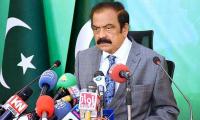Politics has become hostage to the rich and the powerful elite. It is no longer a force of the masses who could use it against traditional centres of power to negotiate a deal to protect their interests and survival, for socio-economic justice to prevail in society. Such ideology-driven politics seems like a story of the past.
Add to this the passing away of one of Sindh’s prominent female political leaders, Zahida Shaikh, last week. Her death serves as a harsh reminder that committed activists like her and the political movements they built, the political ideals they represented and stood for, are no longer a part of the mainstream discourse and narrative. Born in a small town of Qambar Shahdadkot, formerly a part of district Larkana, Zahida joined the Awami Tehreek, a progressive socialist party. Inspired by China and Vietnam’s peasant revolutions, she dedicated her whole life building a women’s political movement in Sindh. She is matchless in that not only did she not opt for anything else in life – no career, or job or raising a family – she dedicated three decades of her life to politicise Sindh’s downtrodden women.
Inspired by the Sindhiyani Tehreek (Movement of Sindhi Women), Zahida entered politics in the 1980s when Sindhis and Pakhtuns together formed the Awami National Party (ANP) The movement now stands divided into three parties. The one that Zahida remained associated with was led by Rasool Bux Palijo, the second is led by his son, Ayaz Latif Palijo, and a third, named Sindhi Aurantan Ji Tanzeem (a front of the Awami Jamhoori Party), is led by Nazir Qureshi and Zahida Dahri. The last two were split-away factions and have a good presence in several of Sindh’s districts including big cities like Karachi and Hyderabad.
Influenced by revolutionary women leaders heading movements from Palestine to Vietnam, she worked towards building a political army of women – what in Sindhi is known as the ‘Dighan waran wari siyasi fauj’ (the long-haired army). On May 12, 2007, when her fellow party leader Nawaz Kandrani was shot and injured by attackers, she was there in the rally that had gathered to welcome the ousted chief justice, Iftikhar Chaudhry. Most of the roads that night were blocked but Zahida looked after all the women participants who had gathered for the rally.
Under the platform of the Awami Tehreek, one saw thousands of women, largely hailing from poor villages and towns, but if there was any organisational force behind these women, it was Zahida. While many came and left – of whom some managed to change the course of politics – and others opted for different priorities, Zahida was one woman who remained untiringly active and in the lead throughout.
However, where marrying party chief Rasool Bux Palijo groomed her politically, it also overshadowed her own standing and recognition, since many people from within and outside the movement started taking her role for granted. They did not pay attention to the outstanding role she played in the modern political history of Sindh by organising women from Sindh’s lower classes.
The history of women political participation in Sindh does not go back that long. It was the Hur movement, led by Pir Pagara during the British Raj, in the 1940s, that Sindhi households and women began to get politicised. The women of the Hurs were active in providing support to their warriors, but not many such stories were reported and documented. While some women activists participated in the Muslim League’s pre-partition politics, after the creation of Pakistan it took a while for Sindhi women to claim their space and earn visibility in a domain seen as a man’s world. It was the anti-One-Unit movement that served as the first critical period for Sindhi women, who openly stepped into politics and, thus, begun the chapter of Sindhi women’s political struggle in modern time.
Zahida was never an elected member of parliament, but she was a hero for thousands of women across Sindh. During the World Social Forum held in Karachi in 2005, her fellow activists under her leadership attended it in huge numbers. Well read in Marxist political literature, if there was a woman who for 30 years organised and managed Sindh’s most creative and restless genius, Rasool Bux Palijo, it was Zahida Shaikh. There was a close to 40-year age difference between the two, but as rebellious as she was, she did not take any social pressure or criticism for wanting to live with a man who already had four wives. She lived with him and breathed her last in his home.
Unlike Sindh’s other political elite who would never allow their women to take part in politics due to their conservative mindset, progressive leaders like Palijo and Fazil Rahu brought their daughters, sons and sisters to the forefront. This was one of the major reasons why the women’s front of the Sindhiyani Tehreek remained very powerful and popular. No other women’s political organisation enjoyed as much popularity and respect within people of the lower classes as did ST during the last three to four decades.
Today we see many women parliamentarians from Sindh, but most of them belong to political families and are there to fill the family quota in parties. Most of these women would not even imagine a world where they would have to lead women’s marches from Sukkur to Karachi to ask for their rights; politics is all about position and status for them. But for people like Zahida, politics was the path to liberation and of struggle, a struggle to awaken the masses to follow the world’s revolutionary tradition and liberate them from their suffering. Unfortunately, it is this non-mainstream path of politics that is fading away, while questions of equality and economic justice continue to remain unaddressed.
Email: mush.rajpar@gmail.com
Twitter: @MushRajpar
BJP leader says that “their politics hinges on security of forces”
Travel services, including flights and hotels, can be booked with Bitcoin through Expedia
It would not be wrong to claim that subject of grand strategy is terra incognita among Pakistan’s policymakers
That is how, alas, system works. Or, at least, this is impression that people are left with
Globally, digital platforms have revolutionised perceptions of work, and Pakistan is no exception
Counselling alone is insufficient; a complete overhaul of education system is needed







